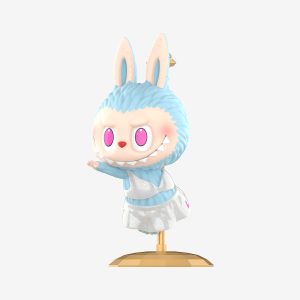From Asia to Berlin: The Rise of Labubu in Germany’s Street Culture
In the ever-evolving world of street culture, where fashion, art, and identity intersect, few symbols have made as much noise in recent years as Labubu. Originally emerging from the Asian art toy scene, Labubu has transitioned far beyond its roots to become a recognizable figure in global urban culture. Nowhere is this more evident than in Germany, particularly in Berlin, where the city’s thriving street scene has embraced Labubu not just as a collectible toy, but as a cultural icon. What began as a niche fascination for collectors has evolved into a lifestyle statement, blending with fashion, music, and the underground aesthetic that Germany is globally known for. The Origins of Labubu Labubu was born from the imagination of Hong Kong-based artist Kasing Lung. Introduced to the art toy world through collaborations with Pop Mart, Labubu embodies the mix of innocence and mischief, with its wide eyes, mischievous grin, and unconventional design. Unlike traditional toys, Labubu was never meant to appeal only to children. Instead, it targeted the growing community of adult collectors and fans of designer toys, tapping into a culture that values limited editions, exclusivity, and artistic storytelling. The toy quickly became a staple in Asia’s streetwear and art communities, aligning itself with the broader movement of collectible vinyl figures. As Asia’s influence on global fashion and subcultures intensified, it was only a matter of time before Labubu found its way into the heart of Europe. Germany’s Street Culture and Its Openness to Global Influences Germany has long been a melting pot for creative subcultures. From graffiti and hip-hop influences in the 1980s to the techno explosion in Berlin after the fall of the Wall, German street culture thrives on innovation and reinvention. Its openness to new trends, particularly those with international origins, has made it fertile ground for influences from Asia. Japanese streetwear, Korean pop culture, and now Asian art toys have all carved out a space within Germany’s fashion-forward youth. Berlin, in particular, plays a critical role. As the cultural capital of Germany, it thrives on its mix of avant-garde artists, underground musicians, and fashion experimenters. In such an environment, Labubu has found a community that appreciates its playful yet rebellious character. The figure fits naturally into Berlin’s ethos of creativity, diversity, and nonconformity. Labubu as a Fashion and Lifestyle Icon What makes Labubu so popular in Germany is not merely its design but the lifestyle it represents. The collectible has been adopted as more than an object; it is a symbol of individuality and artistic taste. Influencers, musicians, and even fashion designers in Berlin have integrated Labubu into their aesthetic, treating it as a marker of belonging to a creative and global subculture. Streetwear brands in Germany have also noticed the trend. Labubu-themed collaborations and capsule collections are beginning to appear, blending the character’s distinctive look with clothing and accessories. In Berlin’s independent fashion boutiques, it is not unusual to see Labubu-inspired designs showcased alongside sneakers, oversized jackets, and graffiti art. The figure has become a tool of self-expression, much like sneakers once were in the 1990s or vinyl toys during the early 2000s. The Role of Social Media and Collectors Another factor driving Labubu’s rise in Germany is the power of social media. Instagram, TikTok, and YouTube have created a thriving ecosystem of collectors who showcase their Labubu pieces, trade limited editions, and share creative setups. German collectors have become part of this global digital community, connecting Berlin with cities like Tokyo, Seoul, and Shanghai. The scarcity and exclusivity of Labubu figures fuel the hype. Limited releases often sell out within minutes, and resale markets make certain editions highly valuable. For German fans, acquiring a Labubu is not just about owning a toy—it is about being part of a movement that values rarity, creativity, and community. This culture of collecting has turned Labubu into a social currency, where ownership signals one’s connection to global art and fashion trends. Berlin’s Creative Scene and Labubu’s Fit Berlin’s reputation as a hub for artistic expression makes it the perfect stage for Labubu’s rise. The city has always embraced experimental art, from performance pieces in underground clubs to street murals that transform entire neighborhoods. Labubu fits seamlessly into this landscape, bridging the gap between toy culture and contemporary art. Art galleries and pop-up exhibitions in Berlin have started including designer toys like Labubu in their displays, challenging the boundary between toys and high art. For younger audiences, this blurring of categories is not confusing—it is liberating. Labubu’s mischievous character mirrors Berlin’s reputation for defying conventions, making it a natural addition to the city’s cultural vocabulary. Beyond Berlin: Germany’s Nationwide Fascination Although Berlin remains the epicenter of Labubu’s rise, the fascination has spread to other parts of Germany. Cities like Hamburg, Munich, and Cologne, with their vibrant art and fashion communities, are also witnessing a growing interest in designer toys. Events such as comic conventions, streetwear fairs, and art festivals provide spaces for Labubu to reach broader audiences. In these cities, Labubu has become a symbol that transcends age groups and artistic disciplines. For some, it is a collectible; for others, a fashion accessory; and for many, a reminder of the global connectedness of today’s youth culture. The Future of Labubu in Germany The rise of Labubu in Germany is more than a passing trend. Its integration into fashion, art, and street culture suggests that it is here to stay. As collaborations with international designers and German streetwear labels increase, Labubu’s presence will likely expand into new forms, including digital art, NFTs, and immersive experiences. Berlin’s openness to experimentation ensures that Labubu will remain a key player in the city’s evolving cultural identity. It represents the fusion of East and West, of toy and art, of playfulness and rebellion. In a city that thrives on breaking boundaries, Labubu feels less like an outsider and more like a natural resident. Conclusion Labubu’s journey from Asia to Berlin reflects the interconnectedness of modern street culture. What started as a niche art toy has grown into a global phenomenon, deeply embedded in Germany’s creative landscape. In Berlin, Labubu has found not just fans but a community that resonates with its spirit of mischief, individuality, and artistic expression. It is no longer just a collectible figure but a cultural emblem of a generation that values creativity over conformity. As Germany continues to embrace global influences, Labubu stands as a reminder that art and culture know no borders. From the streets of Asia to the clubs of Berlin, it has become a symbol of a global movement that celebrates uniqueness, creativity, and the power of imagination.




Leave a Comment